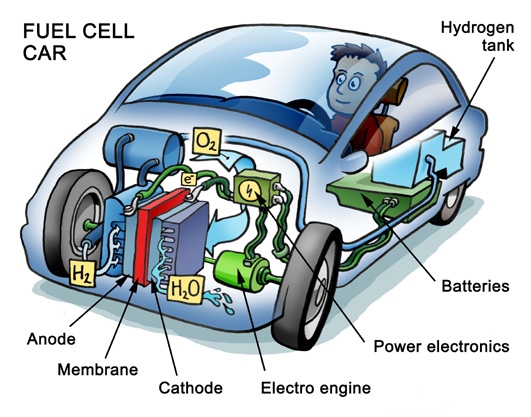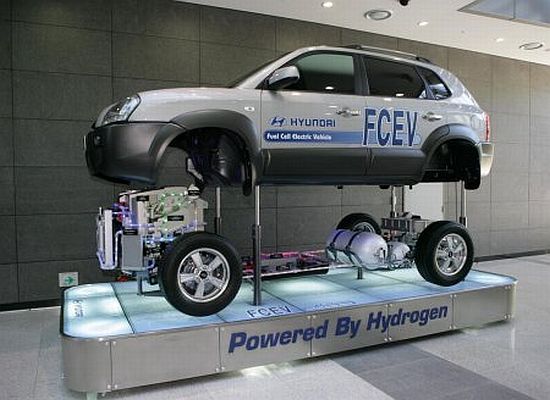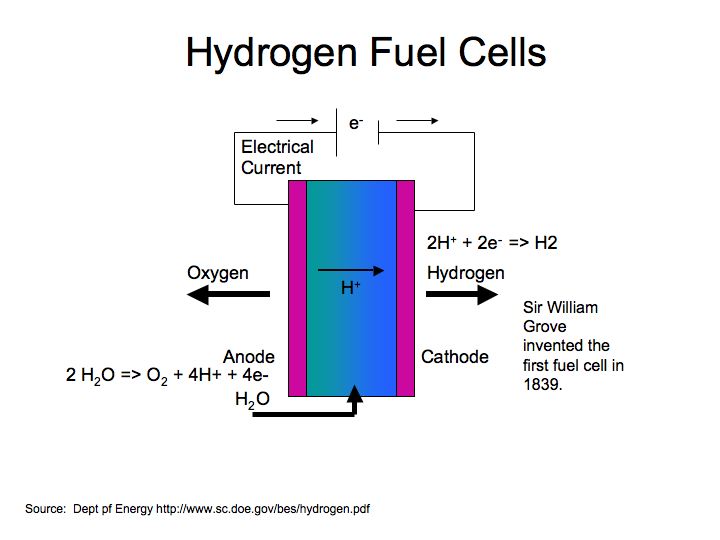 |
| A diagram of how a hydrogen fuel cell would work in a car |
Hydrogen fuel cells are an alternative energy format powered
by, you guessed it, hydrogen. They are typically used in stacks to help
increase efficiency and power. Hydrogen fuel cells have three parts: an anode,
a cathode, and a proton exchange membrane between them. Hydrogen enters the anode and oxygen enters
the cathode. The hydrogen is then split into an electron, which provides energy
to a motor, and a proton, which continues to move through the fuel cells. The
electron and proton join up again at the cathode side, join with the oxygen,
and water is released. Water is the only by-product of a hydrogen fuel cell,
making it an environmentally-friendly alternative with potential to solve fresh
water problems. In fact, hydrogen fuel cells used on space shuttles were used
to supply fresh water to the astronauts on board.
 |
| How hydrogen fuel cells work in a space ship |
 |
| Hydrogen releases less CO2 than gas |
In order to work, a hydrogen fuel cell needs a continuous
supply of its energy source, in other words, hydrogen and oxygen. Oxygen can be
pulled from the air outside the fuel cell, but obtaining hydrogen is much
harder. Hydrogen can be difficult to obtain. Currently, hydrogen is collected
from industrial waste, propane, methane, and other sources that require high
power to generate, but hopefully in the future hydrogen will be harvested from
renewable resources. There are fuel cells that can potentially run on water,
but the concept is very controversial due to Stanley Meyer’s falsified water
fuel cell. An easy to access hydrogen source would need to be found or created
before we can power the world on hydrogen fuel cells alone. Plus, fuel cells
are still relatively expensive to manufacture, however their price is expected
to drop dramatically in the future.
 |
| The Hyundai Tucson Fuel Cell car |
To make hydrogen fuel cells work on a large scale, some sort
of hydrogen infrastructure needs to be developed to distribute hydrogen where
needed. Hydrogen fuel storage and conversion methods are currently in
development, yet they still need a lot of work. Hydrogen can be transported as
a gas or liquid through current energy transportation methods like pipelines and
trucks, but for the most part hydrogen could be produced on-site at power
plants, fueling stations, and anywhere else it may be needed for fuel cells. Integration
into currently existing structures may be somewhat difficult and places
requiring hydrogen for power may need to be retrofitted to produce hydrogen.
Hydrogen fuel cells could be part of either a centralized or decentralized
system, it just depends upon the decisions of those who implement it. Hydrogen
fuel cells can be modified to run off-grid, they just need to have some source
of hydrogen in order to work.
 Hydrogen fuel cells have already been used for
transportation, from powering space shuttles to prototype cars like the Toyota
FCV or the Hyundai Tucson Fuel Cell. For the hydrogen fuel cell cars, there is
a problem with lack of hydrogen fueling stations, but that is something that
can easily be remedied by a change in infrastructure. Already steps have been
taken to encourage people to adopt hydrogen fuel cell technology. There are
currently a federal tax incentives and credits for people who use residential
hydrogen fuel cells, businesses who invest in hydrogen fuel cells, and stations
who build hydrogen fueling stations. Many companies who manufacture hydrogen
fuel cells are actively working to lower manufacturing times and increase their
output in order to make these products cheaper and more available. Many people
are motivated to invest in hydrogen fuel cell technology because of their
concern for the environment and the promise this fuel type holds for the
future. Overall, many believe that a “hydrogen economy,” or a world where
hydrogen is the main source of fuel, is in our future, and hydrogen fuel cells
help to bring us closer to that future.
Hydrogen fuel cells have already been used for
transportation, from powering space shuttles to prototype cars like the Toyota
FCV or the Hyundai Tucson Fuel Cell. For the hydrogen fuel cell cars, there is
a problem with lack of hydrogen fueling stations, but that is something that
can easily be remedied by a change in infrastructure. Already steps have been
taken to encourage people to adopt hydrogen fuel cell technology. There are
currently a federal tax incentives and credits for people who use residential
hydrogen fuel cells, businesses who invest in hydrogen fuel cells, and stations
who build hydrogen fueling stations. Many companies who manufacture hydrogen
fuel cells are actively working to lower manufacturing times and increase their
output in order to make these products cheaper and more available. Many people
are motivated to invest in hydrogen fuel cell technology because of their
concern for the environment and the promise this fuel type holds for the
future. Overall, many believe that a “hydrogen economy,” or a world where
hydrogen is the main source of fuel, is in our future, and hydrogen fuel cells
help to bring us closer to that future.
A video of a DIY hydrogen fuel cell. This man is NOT a professional, so I don't recommend actually attempting to use his prototype to power your car, but it's still interesting how he got it to work.

This is an interesting topic and this has a lot of great information. Great post.
ReplyDeleteGreat topic and great way of explaining how hydrogen fuel cells work.
ReplyDeletegreat topic it was very interesting
ReplyDelete